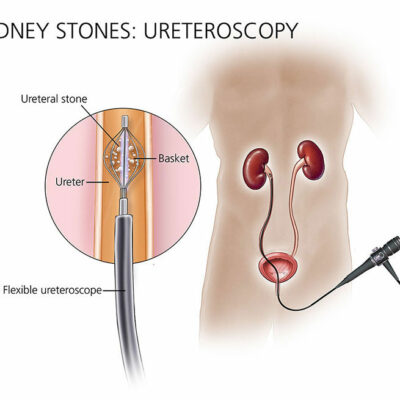Precision lasers and minimally invasive surgery are used to treat most kidney stones.
Kidney stones occur more commonly in men than women and the age group most affected is 20-40 years. Although having a stone in your urinary tract is often very painful, some stones may go unnoticed for months or even years and not cause any symptoms. Kidney stones usually need to be removed – if left untreated, they could be dangerous and cause complications such as kidney damage and severe infection (sepsis). About half of people who get a kidney stone will develop another one within 10 years.
The following factors may increase a person’s risk of developing a kidney stone:
- Living in a warm climate
- Inadequate water intake
- Diet – eating too much red meat
- Repeated urinary tract infections
- Structural abnormalities of the urinary tract
- Obstruction of the urinary tract
- Previous surgery on the urinary tract
- Metabolic abnormalities (the body doesn’t handle salts correctly: calcium, magnesium, phosphate) – this is relatively rare
- Some medication – this is also an uncommon cause of kidney stones
The different types of kidney stones
Calcium stones:
This is the most common type; 75% of all stones consist mainly of calcium. These stones are rarely pure calcium and more often a mix of calcium phosphate or calcium oxalate. These stones are hard but modern surgical lasers can break them up easily.
Struvite stones:
These stones are caused by recurrent infections in the urinary tract. The stones consist of calcium, ammonium, magnesium, and phosphate. They can become very large and can even fill the entire kidney if left untreated. This is a relatively soft type of stone. Bacteria often colonize (hide away inside) struvite stones and are difficult to eradicate with antibiotics only.
Uric acid stones:
These stones can form as a result of eating too much red meat. Other causes of uric acid stones include gout and bowel diseases (chronic diarrhea). These stones are not visible on plain X-rays – a CT scan is necessary to identify them.
Cysteine stones:
These are very rare and are found only in people who are born with a specific metabolic abnormality. Cysteine stones usually occur in young people and even small children.
The signs and symptoms of kidney stones
A patient with a stone in the urinary tract may have the following complaints:
- Severe pain in the side / back – the severity of the pain has been compared to childbirth… The pain typically comes and goes in waves – this is called renal colic. The pain may spread to the back, the lower abdomen, the bladder and even the genitals.
- Blood in the urine.
- Fever.
- No symptoms – some patients with kidney stones have no pain or other complaints and the stones are merely picked up when X-rays or scans are done for other reasons.
Kidney stones may be treated in various ways
Surgical procedures used to treat kidney stones
Endoscopic stone removal:
This is my preferred method for treating kidney stones – about 90% of my patients are suitable for this kind of minimally invasive surgery. Specialized small cameras (endoscope), precision lasers, and tiny instruments are used to remove stones from any part of the urinary tract, without making surgical incisions on the skin. Even large stones can be broken into tiny bits using a laser – the fragments can then be easily removed using entrapment baskets or grasping forceps. Most patients will go home the same day after this procedure (ie no overnight stay in hospital required) and recovery is usually quick. In some cases a small silicone stent (JJ-stent) is placed into the kidney pipe for a few days following the operation to facilitate recovery.
Shockwave treatment (ESWL):
This is also called Extracorporeal Shockwave Lithotripsy (ESWL). It is useful for the treatment of small stones located in the kidney and ureter. A general anaesthetic is usually needed but no surgical incisions are made. ESWL treatment is given with a large machine that produces shockwaves. The shockwaves are directed into the body and concentrated on the stone – sending repeated shockwaves into the stone will eventually cause it to break up into smaller pieces, which can then pass on their own. Typically, about 5000 shockwaves are given per treatment and the entire procedure lasts about 45 minutes. Not all stones are suitable for this kind of treatment – stones that are very hard may be resistant to ESWL and will not break into smaller pieces.
Percutaneous nephrolithotomy (PCNL):
This is a more invasive surgical procedure that is used to remove very large stones from the kidney. It can be a long operation (anything from 1 to 4 hours, depending on the size and location of the stone) and patients usually spend a few nights in hospital. Through a small skin incision, a camera is placed into the kidney and the stone located. A thin drill or laser is then passed alongside the camera and the large kidney stone broken into smaller pieces, which are then removed with special instruments.
Open surgery:
Nowadays it is hardly ever necessary to make big surgical incisions in order to remove kidney stones because most stones can be removed using the other (less invasive) methods.

